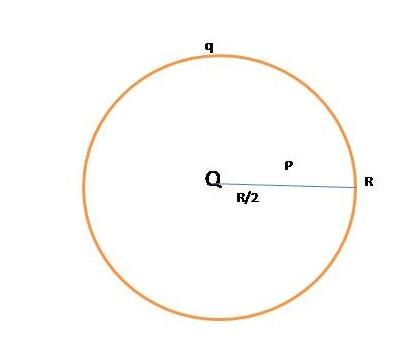
A thin spherical conducting shell of radius of radius R has a charge q. Another charge Q is placed at the center of the shell. The electrostatic potential at a point P which is at a distance $\dfrac{R}{2}$ from the center of the shell is:
A) $\dfrac{{2Q}}{{4\pi {\varepsilon _o}R}} - \dfrac{{2q}}{{4\pi {\varepsilon _o}R}}$
B) $\dfrac{{2Q}}{{4\pi {\varepsilon _o}R}} + \dfrac{{2q}}{{4\pi {\varepsilon _o}R}}$
C) $\dfrac{{Q + q}}{{4\pi {\varepsilon _o}R}} + \dfrac{2}{R}$
D) $\dfrac{{2Q}}{{4\pi {\varepsilon _o}R}}$
Answer
217.8k+ views
Hint: Here we just have to find the electric potential due to a hollow conducting shell. In the shell the electric potential remains the same i.e. the electric potential is uniform inside and on the shell. We have to find electric potential at point p which lies inside the shell due to charge on the surface of the shell q and the charge inside the shell Q. Hence the total potential will be the summation of the two electric potentials.
Formula Used:
$V = \dfrac{{Kq}}{R}$ ;
Where:
V= Electric Potential;
K= Proportionality Constant,$(K = \dfrac{1}{{4\pi {\varepsilon _o}}})$
q= Charge,
R= Distance.
Complete step by step answer:
Step1: Write the electric potential due to charge q and Q.

Electric potential due to q
$V = \dfrac{{Kq}}{R}$;
Put the value of R as: $R = \dfrac{R}{2}$
$\implies$ $V = \dfrac{{2Kq}}{R}$
Electric potential due to Q
$\implies$ ${V_1} = \dfrac{{KQ}}{R}$
Put the value of R as:$R = \dfrac{R}{2}$
$\implies$ ${V_1} = \dfrac{{2KQ}}{R}$;
Step2:
Combine the two potentials to find out the total electric potential
${V_F} = V + {V_1}$
Put the values,
${V_F} = \dfrac{{2KQ}}{R} + \dfrac{{2Kq}}{R}$ ;
Put the value of K as$(K = \dfrac{1}{{4\pi {\varepsilon _o}}})$, in the above equation we have,
$V = \dfrac{{2Q}}{{4\pi {\varepsilon _o}R}} + \dfrac{{2q}}{{4\pi {\varepsilon _o}R}}$
Final Answer: The electrostatic potential at point P due to q and Q is Option B) $V = \dfrac{{2Q}}{{4\pi {\varepsilon _o}R}} + \dfrac{{2q}}{{4\pi {\varepsilon _o}R}}$.
Note: Here first find out the electric potential due to q and then electric potential due to Q. The distance between point p and charge q is (R/2) and not (R). Put the formula for electric potential, as it is uniform inside the shell it would be the same on the shell also and find the combined potential.
Formula Used:
$V = \dfrac{{Kq}}{R}$ ;
Where:
V= Electric Potential;
K= Proportionality Constant,$(K = \dfrac{1}{{4\pi {\varepsilon _o}}})$
q= Charge,
R= Distance.
Complete step by step answer:
Step1: Write the electric potential due to charge q and Q.

Electric potential due to q
$V = \dfrac{{Kq}}{R}$;
Put the value of R as: $R = \dfrac{R}{2}$
$\implies$ $V = \dfrac{{2Kq}}{R}$
Electric potential due to Q
$\implies$ ${V_1} = \dfrac{{KQ}}{R}$
Put the value of R as:$R = \dfrac{R}{2}$
$\implies$ ${V_1} = \dfrac{{2KQ}}{R}$;
Step2:
Combine the two potentials to find out the total electric potential
${V_F} = V + {V_1}$
Put the values,
${V_F} = \dfrac{{2KQ}}{R} + \dfrac{{2Kq}}{R}$ ;
Put the value of K as$(K = \dfrac{1}{{4\pi {\varepsilon _o}}})$, in the above equation we have,
$V = \dfrac{{2Q}}{{4\pi {\varepsilon _o}R}} + \dfrac{{2q}}{{4\pi {\varepsilon _o}R}}$
Final Answer: The electrostatic potential at point P due to q and Q is Option B) $V = \dfrac{{2Q}}{{4\pi {\varepsilon _o}R}} + \dfrac{{2q}}{{4\pi {\varepsilon _o}R}}$.
Note: Here first find out the electric potential due to q and then electric potential due to Q. The distance between point p and charge q is (R/2) and not (R). Put the formula for electric potential, as it is uniform inside the shell it would be the same on the shell also and find the combined potential.
Recently Updated Pages
Arithmetic, Geometric & Harmonic Progressions Explained

Cartesian Form of Vector Explained: Formula, Examples & Uses

Apparent Frequency Explained: Formula, Uses & Examples

Calorimetry: Definition, Principles & Calculations

Centrifugal Force Explained: Definition, Formula & Examples

Charge in a Magnetic Field: Definition, Formula & Examples

Trending doubts
Understanding Collisions: Types and Examples for Students

Ideal and Non-Ideal Solutions Explained for Class 12 Chemistry

Degree of Dissociation: Meaning, Formula, Calculation & Uses

Understanding Elastic Collisions in Two Dimensions

A particle moves in a straight line according to the class 11 physics JEE_MAIN

Understanding Newton’s Laws of Motion

Other Pages
Gravitation Class 11 Physics Chapter 7 CBSE Notes - 2025-26

NCERT Solutions For Class 11 Physics Chapter 13 Oscillations - 2025-26

Motion In A Plane Class 11 Physics Chapter 3 CBSE Notes - 2025-26

Mechanical Properties of Fluids Class 11 Physics Chapter 9 CBSE Notes - 2025-26

NCERT Solutions For Class 11 Physics Chapter 12 Kinetic Theory - 2025-26

Inertial and Non-Inertial Frame of Reference Explained




